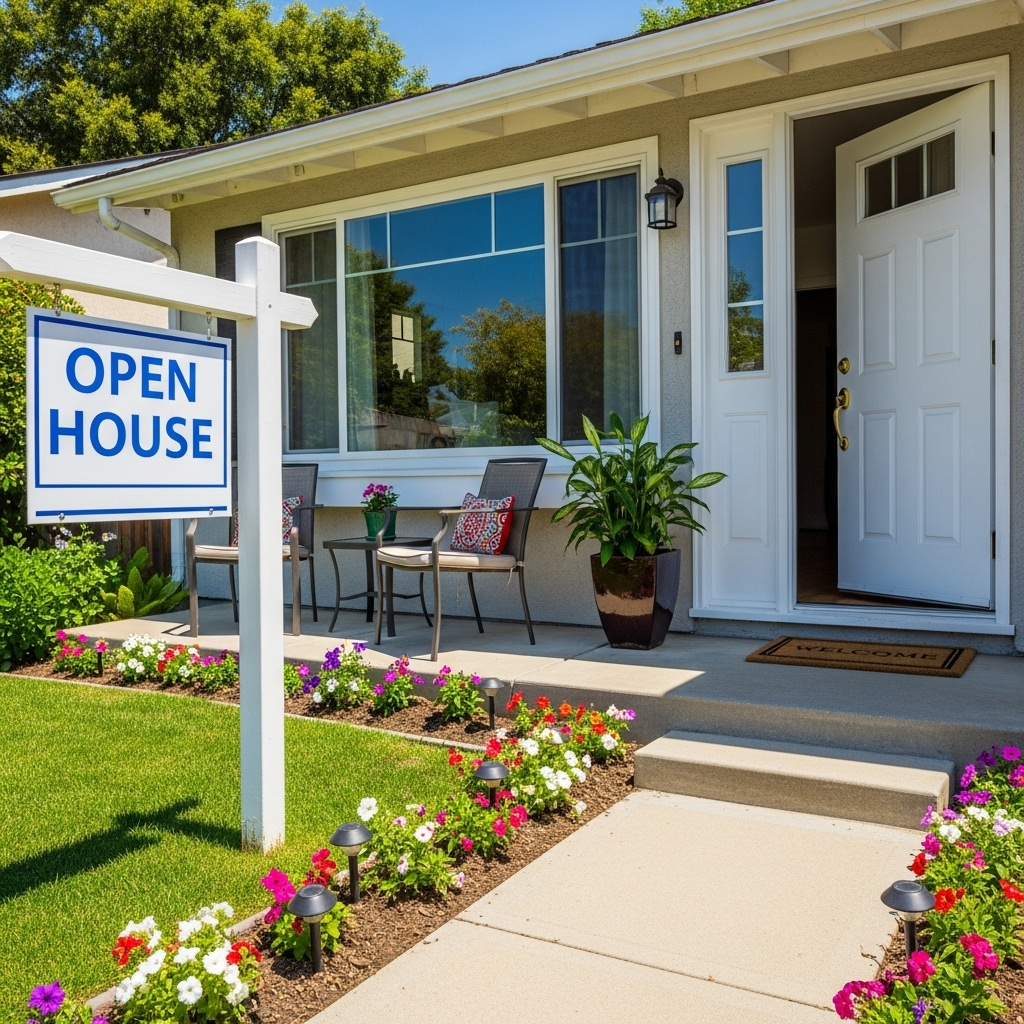The Power of First Impressions in Today’s Competitive Market
Preparing for an open house is like hosting a party where you never meet the guests—it’s stressful and a little odd. Buyers today have high expectations; they want a home that feels “as close to perfect as the sellers can possibly afford,” explains Zinta Rodgers-Rickert, a top-selling real estate agent with 35 years of experience in Fairfax County, Virginia. Gone are the days when sellers could skip tidying up; even small details now significantly impact buyer perception.
Hosting an open house is a powerful strategy to attract buyers and showcase your property. However, a successful event requires more than unlocking your doors and hoping for the best. Proper planning ensures your home stands out in a competitive market and appeals to serious buyers. According to industry experts, 47% of buyers attend open houses to see if a home matches their online expectations, making the preparation phase absolutely critical to your selling success.
Pro Tip: The 30-30-30 Rule
When preparing your home, allocate 30% of your time to deep cleaning, 30% to strategic staging, and 30% to creating an emotional connection through sensory elements. The final 10% should focus on digital integration to bridge the gap between online marketing and in-person experience.

Timing: The Strategic Advantage You Can’t Ignore
Choosing the right day and time for your open house can dramatically affect attendance and buyer quality. The sweet spot for most markets is Sunday between 1-4 PM, when buyers have time to visit without work constraints. However, for luxury properties or areas with busy professionals, Saturday morning or Thursday evening might yield better results. Consider neighborhood patterns—avoid scheduling during local festivals, major sporting events, or holidays when potential buyers may be occupied.
Weekend open houses typically attract more visitors, but they often bring casual browsers rather than serious buyers. Midweek appointments, while less common, frequently draw more qualified prospects who have already done their online research. According to Redfin, timing your open house within 72 hours of listing can capitalize on initial market excitement and generate the most traffic.
| Timing Factor | Best Practice | Impact Level |
|---|---|---|
| Day of Week | Sunday (1-4 PM) for most markets | High |
| Season | Spring/Summer for most regions | Medium |
| After Listing | Within 72 hours | High |
| Competition | Avoid overlapping with nearby open houses | Medium |
| Weather | Check forecast; reschedule for severe conditions | High |
Pro Tip: The 15-Minute Window
Open your doors 15 minutes before the scheduled start time. This allows early arrivals to view the property without feeling rushed, creating a more relaxed atmosphere that encourages longer visits and deeper engagement with your home.
Deep Cleaning: Beyond Surface-Level Sparkle
Gone are the days when a quick vacuum and wipe-down suffice. Today’s buyers scrutinize every corner, searching for signs of neglect that might indicate larger issues. Start your cleaning regimen at least two weeks before your open house, focusing on areas buyers inspect most: bathrooms, kitchens, windows, and floors. Pay special attention to often-overlooked spots like baseboards, light fixtures, and cabinet interiors—these details signal to buyers that the home has been meticulously maintained.
Professional deep cleaning is a worthwhile investment, especially for high-traffic areas and specialized surfaces. Steam clean carpets, power wash exteriors, and consider hiring specialists for window cleaning and upholstery. As emphasized by HAR.com, “every detail matters from choosing the correct date to staging the property effectively.” Buyers today expect pristine conditions, and any visible dirt or grime can raise red flags about the home’s overall condition.
Strategic Staging: Creating Emotional Connections
Staging isn’t just about making a home look good—it’s about helping buyers imagine themselves living there. Remove personal items, clutter, and overly specific decor that might distract from the home’s potential. Focus on creating neutral, inviting spaces that appeal to a broad audience while highlighting your property’s unique features. A professionally staged home typically sells for 5-20% more than non-staged properties, according to industry data.
The kitchen and living areas deserve special attention, as they’re often the most important rooms for buyers. Stage the kitchen with fresh fruit, a cookbook open on the counter, and minimal appliances visible. In living spaces, arrange furniture to showcase flow and create conversation areas. As Homes.com notes, “each home is unique depending upon location, price point and layout, which makes it critical for the buyer to see it for themselves.”
Pro Tip: The “Empty Chair” Technique
Leave one chair slightly pulled out at the dining table or kitchen island. This subtle detail invites buyers to sit and imagine themselves in the space, creating an unconscious emotional connection that can significantly influence their perception.
Curb Appeal: Your Home’s First Introduction
First impressions happen before buyers even step inside—they form while driving up to your property. Invest in landscaping, pressure wash exterior surfaces, and ensure your front door is welcoming. A fresh coat of paint on the front door (in a color that complements your home’s style) can significantly boost curb appeal. Add potted plants or flowers to create visual interest and demonstrate care for the property.
The driveway and walkways should be clean and free of debris. If your neighborhood allows, place a tasteful welcome mat by the front door. Consider adding subtle lighting to highlight architectural features or pathways. According to real estate professionals, 79% of buyers form their first impression based on curb appeal alone, making this an area where small investments yield significant returns.
Sensory Experience: Engaging All Five Senses
Creating a multisensory experience transforms a standard viewing into a memorable event that resonates with potential buyers. The right scent—subtly baking cookies or using a light, neutral diffuser—can create warmth and comfort. Play soft background music at a low volume to mask external noises and create a welcoming atmosphere. Ensure the temperature is comfortable (68-72°F) and that the home feels inviting to touch with soft textiles in key areas.
The visual experience should be consistent throughout—turn on all lights to showcase the home’s best features, including outdoor lighting during evening viewings. For taste, consider offering bottled water or a simple refreshment station with neutral options. As emphasized by industry experts, buyers form judgments based on sensory cues before they even consciously evaluate the property’s features.
Open House Sensory Checklist
| Sense | Implementation | Impact |
|---|---|---|
| Sight | Fresh flowers, full lighting, decluttered spaces | High |
| Smell | Subtle baking scent, clean air, no pet odors | High |
| Sound | Soft background music, quiet environment | Medium |
| Touch | Soft textiles, comfortable temperatures | Medium |
| Taste | Water or simple refreshments | Low-Medium |
Digital Integration: Bridging Online and In-Person
Your open house should seamlessly connect with your digital marketing strategy. Create a QR code that links to your property’s listing, virtual tour, and neighborhood information. Place it discreetly near the front door for easy scanning. Provide printed materials with key property features, neighborhood highlights, and your agent’s contact information.
Leverage social media to build anticipation—announce your open house on relevant platforms 3-5 days in advance with captivating visuals. During the event, consider having a designated person take professional photos (with buyer permission) for immediate social sharing. As Redfin emphasizes, “an open house is among the best opportunities to make a first impression,” and integrating digital tools can significantly extend that impression beyond the physical event.
The Seller’s Role: Strategic Absence
Most real estate professionals recommend that sellers leave during open houses. Your presence can make buyers uncomfortable, inhibiting their ability to speak freely with agents or fully explore the space. If you must stay, remain in a separate area and avoid engaging with potential buyers directly—this can create awkwardness and potentially derail negotiations.
Instead, focus on preparing the home thoroughly beforehand and trust your agent to represent it effectively. As noted by HAR.com, “a successful event requires more than unlocking your doors and hoping for the best.” Your preparation is your contribution; the actual event belongs to your agent and potential buyers.
Measuring Success and Effective Follow-Up
Track your open house success through specific metrics: number of visitors, quality of leads, buyer feedback, and subsequent showings. Provide your agent with a sign-in sheet that captures essential information while respecting privacy regulations. The most valuable open houses generate qualified leads rather than just high traffic numbers.
Follow up within 24 hours with personalized messages to each visitor. Reference specific aspects they mentioned during their visit to demonstrate attentiveness. For serious prospects, schedule a private showing within 48-72 hours while their interest is still fresh. According to industry data, 68% of buyers who attend open houses will request additional viewings if they receive prompt, personalized follow-up.
Essential Open House Preparation Timeline
| Timeframe | Key Tasks | Critical Items |
|---|---|---|
| 4-6 Weeks Out | Professional deep cleaning, repairs, landscaping | Fix structural issues, replace worn carpets |
| 2-3 Weeks Out | Staging consultation, decluttering, professional photography | Remove personal items, optimize room flow |
| 1 Week Out | Final cleaning, scent preparation, lighting check | Test all lights, set temperature controls |
| Day Before | Final walkthrough, refresh supplies, test tech | Stock guest book, charge devices |
| Day Of | Set up refreshments, adjust lighting, welcome materials | Create welcome packet, set background music |
Advanced Strategies for Competitive Markets
In saturated markets, differentiation is key. Consider adding a neighborhood guide highlighting nearby amenities, schools, and attractions. Some sellers provide virtual reality headsets for buyers to explore the home in 3D after leaving. Others create “lifestyle brochures” showcasing how the home fits into various buyer personas (families, professionals, empty nesters).
For luxury properties, consider partnering with local businesses for elevated experiences—a local chef might prepare light refreshments, or a florist could create custom arrangements. As emphasized by real estate marketing experts, “today’s buyers want a complete experience that goes beyond the physical property.”
Conclusion: The Open House as a Strategic Marketing Tool
Your open house represents far more than just an opportunity to show your home—it’s a carefully orchestrated marketing event designed to generate qualified leads and create emotional connections with potential buyers. By implementing these comprehensive preparation strategies, you transform a simple viewing into a memorable experience that positions your property above the competition.
Remember that in today’s real estate market, buyers have more options than ever. A well-executed open house can be the difference between a home that sits on the market and one that receives multiple offers. As HomeLight advises, “by starting your preparations at least a month in advance and following this comprehensive guide, you’ll cover every detail and impress potential buyers from the moment they step through the door.”
The most successful open houses don’t happen by accident—they result from meticulous planning, attention to detail, and understanding what today’s buyers truly want. With these strategies in place, your open house won’t just attract visitors; it will generate serious offers and help you achieve your selling goals in the most efficient, profitable way possible.
